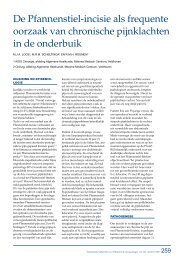Surgical management of chronic inguinal pain syndromes - Liespijn
Surgical management of chronic inguinal pain syndromes - Liespijn
Surgical management of chronic inguinal pain syndromes - Liespijn
You also want an ePaper? Increase the reach of your titles
YUMPU automatically turns print PDFs into web optimized ePapers that Google loves.
INTRODUCTIONThe introduction <strong>of</strong> mesh techniques in groin hernia surgery has reduced recurrencerates but has rekindled interest in postherniorrhaphy <strong>pain</strong> <strong>syndromes</strong>. Several tools forassessment <strong>of</strong> <strong>pain</strong> severity are currently utilized. The McGill Pain Questionnaire 1 and theWisconsin Brief Pain Questionnaire 2 are multidimensional <strong>pain</strong> questionnaires assessingsensory, affective and evaluative aspects <strong>of</strong> <strong>pain</strong>. In contrast, the Visual Analogue Scale(VAS), Verbal Rating Scale (VRS) and Numerical Rating Scale (NRS) are simple unidimensionaltests which only rate sensory components <strong>of</strong> <strong>pain</strong> and omit affective andpsychosocial <strong>pain</strong> aspects. Researchers <strong>of</strong>ten rely on unidimensional systems 3 as multidimensionalquestionnaires are generally considered too long and too complicated.The widely used VAS represents a 100 mm horizontal line with on the one end written‘no <strong>pain</strong>’ (score 0) and on the other end ‘unbearable <strong>pain</strong>’ (score 100). Individuals areinstructed to put a mark along this line at a position that is currently reflecting theirintensity <strong>of</strong> <strong>pain</strong>. A VAS test may allow for rapid completion and harbours a high sensitivity.However, its conceptual complexity may result in a high non-compliance rate orscale failure, particularly in elderly patients with cognitive and psychomotor impairments4 . In contrast, a VRS exists in several versions ranging from a simple 4-point(no <strong>pain</strong>, mild, moderate or severe <strong>pain</strong>) to a more complex 15-point list. A VRS excels insimplicity but may lack sensitivity due to its ordinal character 4 .Author Year Unidimensional Multidimensional1. Cunningham 8 1996 NRS/ VRS (4-point)2. Callesen 9 1999 VRS (4-point)3. Bay-Nielsen 10 2001 VRS (4-point)4. Poobalan 11 2001 McGill 45. Courtney 12 2002 SF-36 5 / Wisconsin 66. Page 5 2002 VAS 37. Kumar 13 2002 Presence <strong>of</strong> <strong>pain</strong>/discomfort?8. Lau 14 2003 VRS (4-point)9. Mikkelsen 18 2004 McGill10. Grant 15 2004 VRS (5-point)11. Nienhuijs 6 2005 VAS12. O’Dwyer 16 2005 VAS/ VRS (5-point)13. Franneby 17 2006 DIBS 714. Loos 7 2007 VASTable 1 Pain measurement tools used in postherniorrhaphy groin <strong>pain</strong> literature.NRS = Numerical Rating Scale, VRS = Verbal Rating Scale, VAS = Visual Analogue Scale, McGill = McGill Pain questionnaire,SF-36 = Short-Form 36, Wisconsin = Wisconsin Brief Pain questionnaire, DIBS = Duration-Intensity-Behavior-Scale.The ideal <strong>pain</strong> assessment tool should be determined by type <strong>of</strong> <strong>pain</strong> and the settingin which it is measured. Unidimensional scales have routinely been employed in theevaluation <strong>of</strong> postherniorrhaphy groin <strong>pain</strong> <strong>syndromes</strong>. Which <strong>pain</strong> rating scale servesbest under these circumstances is unknown since a gold standard is lacking. A randomlist <strong>of</strong> groin <strong>pain</strong> studies and employed <strong>pain</strong> assessment tools is depicted in Table 1 5-8 .Some investigators used VAS tests to investigate groin <strong>pain</strong> intensity 5,6 . To convert VASinto VRS scores, cut-<strong>of</strong>f points are mandatory. These investigators introduced VAS cut<strong>of</strong>fpoints on arbitrary grounds (0 mm = no <strong>pain</strong>, 50 mm = severe <strong>pain</strong>) 5 while other general <strong>pain</strong> researchers suggested differentcut-<strong>of</strong>f points 19-22 .Aim <strong>of</strong> this study was to evaluate two frequently used <strong>pain</strong> rating scales (VAS and4-point VRS) for scale failure, and to determine which test performs better in patientsfollowing groin hernia repair.PATIENT AND METHODSThe present study was based on <strong>pain</strong> data obtained from a questionnaire among postherniorrhaphycases 7 . Patients with a groin hernia repair between January 2000 andAugust 2005 in the Máxima Medical Center received a postal questionnaire in February2006. The Máxima Medical Center is a teaching hospital serving a total population <strong>of</strong>approximately 175,000 inhabitants. Each individual was asked to grade their presentgroin <strong>pain</strong> intensity on a 4-point VRS (no <strong>pain</strong>, mild, moderate or severe <strong>pain</strong>) followedby a VAS (0-100 mm). Brief written instructions regarding the VAS were providedwhereas VRS instructions were deemed unnecessary. Results were analyzed for scalefailure, which was defined as a situation in which the patient did not complete the <strong>pain</strong>rating scale, or if the response could not be coded to a unique score.Statistical analysis was carried out using the Statistical Package for the Social Sciences(SPSS), Windows version 12.0.1. An ‘outlier’ in Figure 1 was defined as a position between1.5 and 3 box lengths from the upper or lower interquartile range. Similarly, an ‘extremecase’ was defined as a position more than 3 box lengths removed from the upper orlower interquartile range. Mean and median VAS scores per VRS category with standarddeviation and range were calculated. Frequency distribution <strong>of</strong> paired VAS-VRS datausing different cut-<strong>of</strong>f points for VAS classification was evaluated by means <strong>of</strong> squarecontingency tables. Optimal VAS cut-<strong>of</strong>f points were identified in such a way that theVAS-classification concurred optimally with VRS-answers creating the optimal kappacoefficient. Using these optimal cut-<strong>of</strong>f points, a subgroup analysis for sex and age wascarried out to detect any difference in kappa. Kappa coefficients were compared afterapplication <strong>of</strong> Page’s cut-<strong>of</strong>f points 5 (0 mm= no <strong>pain</strong>, 50 mm = severe <strong>pain</strong>) on the current data set.54 Chapter 4Evaluating postherniorrhaphy groin <strong>pain</strong>: Visual Analogue or Verbal Rating Scale? 55





